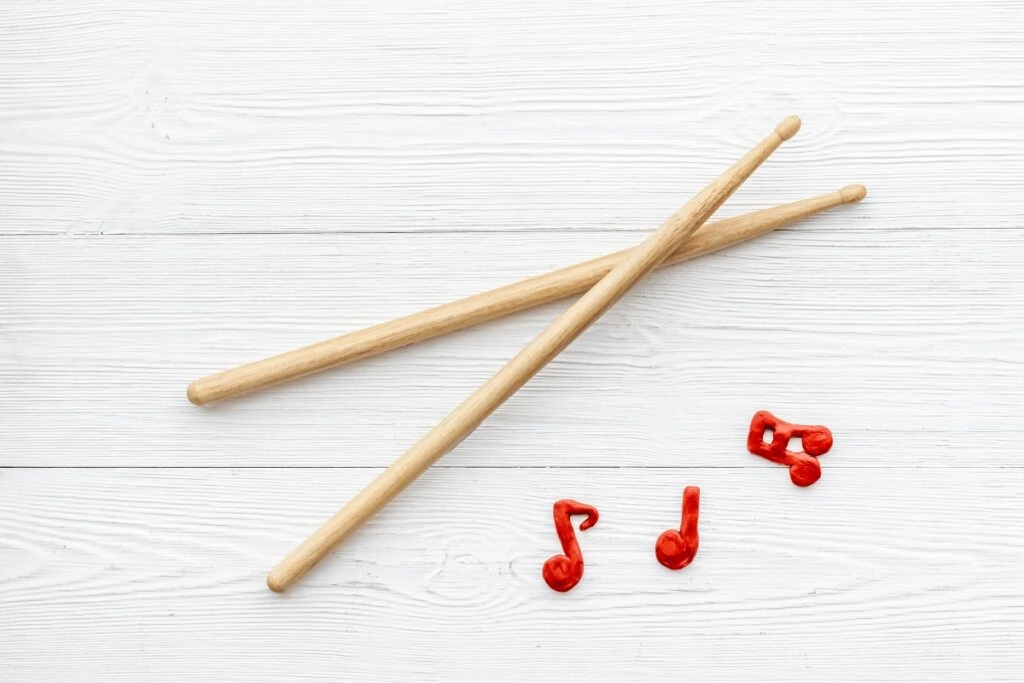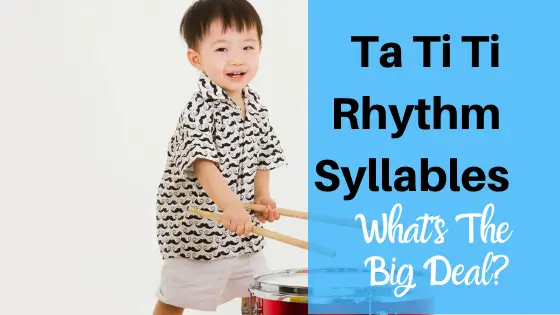As a music teacher, I’m sure you’ve heard some other teachers mention and use the “ta ti ti” rhythm syllables.
“Ta ti ti” rhythm syllables are a common rhythm syllable system used by Kodaly-inspired teachers. This system replaces the names of the rhythmic values with syllables that make them easier to be performed and internalized.
Read on for more information including examples of how to use them.

Save time with these 60 FREE Music Resources to use in your room right away!
Stop searching the whole internet to find good activities. I’ll help you cut to the chase with my favorite 60 FREE resources.
Table of Contents
The Breakdown
In this section, we’ll break down what Kodaly rhythm syllables (or Ta Ti Ti rhythm syllables) are. I’ll also include short-form pros and cons for the standard system.
Read more about Kodaly training.
This rhythm system replaces note values with syllables to make the rhythms easier to perform, read, and hear inside (often called audiation).
There are forms of this system which change the “ta” syllable to match the beat in different time signatures. This is a beat-function form of the system similar to Froseth’s “Du-de” syllables used in Conversational Solfege and other main methods.
The following rhythm values are commonly used as follows:
- Quarter note – ta
- Paired eighth notes – ti ti
- All rests – (no sound)
- Half notes – ta-ah or too
- Whole note – ta-a-a-ah or too-oo
- Sixteenth notes – tiri tiri or tika tika
- Eighth-quarter-eighth – syn-co-pa
- Dotted quarter-eighth – tam-ti
- Dotted eighth-sixteenth – tim-ka
Pros And Cons
There are some clear pros and cons of using ta ti ti rhythm syllables.
Some will argue this is the only way to go, and others will argue that it isn’t any good at all.
In reality, most rhythm counting systems will work just fine; just be consistent and the students end up learning their rhythms well.
Pros For The Ta Ti Ti Counting System:
- Syllables help perform rhythms
- Build language connections in the brain
- Used by many other music teachers
- Quick learning of rhythm values
Cons For The Ta Ti Ti Counting System:
- Doesn’t change to match time signature (usually)
- Syllables don’t follow the beat
- Syllables may make upper elementary students laugh
4 Examples Of Rhythm Activities With Ta Ti Ti Rhythm Syllables

There are hundreds of activities out there you can use ta and ti ti rhythm syllables with to teach students more about rhythms, but here are 4 of my favorites.
These activities can be used for any grade level and adapted to use any rhythm syllables.
#1 Flashcard Challenge
The flashcard challenge is my version of a common flashcard reading activity. You can do this with any set of flashcards with specific rhythms on them.
I always enjoy the Conversational Solfege flashcards (click to check price and product info).
I present it to students as different levels they have to pass. Go through a whole set of rhythms before moving on to the next level.
The levels go like this:
- T says: “1, 2, ready, say.” Students read rhythm.
- Students read all rhythms in a row.
- Split class in two and alternate cards.
- Students only read certain rhythms (only say the quarter notes).
- Split class into small groups and each group says only certain rhythms.
Note: Try to really play up the challenge of the rhythms. I do dramatic voices and make it like a game.
#2 Rhythm Train
Rhythm train is a fun way to assess rhythmic understanding and work on students’ improvisation skills.
- Students think of a 4 or 8 beat rhythm using the concepts you’re working on.
- Each student says the rhythm one at a time while the teacher walks around the room.
Sounds simple, but it can be tricky. I find it helpful to play a beat on a drum while students say their rhythms.
As a challenge, I tell them they have three “wobbles” before the train crashes. They earn wobbles by:
- Saying the rhythm to an unsteady beat
- Forgetting your rhythm
- Performing a rhythm incorrectly
- Making a rhythm not in the correct amount of beats
I’m not usually picky the first couple of times we play, but I get tougher as we go.
If you’re kids are having a tough time sorting between beat vs. rhythm, check out our guide at the link.
#3 Mix-Pair-Perform
Students move around the room to recorded music or sing a song. At the end or when you pause the music, students pair up with the nearest person.
Taking turns, students perform a rhythm with your concepts. They keep going until you give a quiet signal.
Then, they thank each other for sharing.
Pro-tip: Have students who don’t have a partner walk to the front of the room to see who else is missing a partner easier.
This is an adaptation of cooperative learning.
#4 Sing-Say-Think
Students have a longer rhythm they need to read. After reading it all with confidence, you challenge them with this activity.
As they perform, you (or a student later on) hits a triangle or other signal. When they hear this signal, they switch to inner hearing.
When you play it again, they switch back to saying the rhythms.
For a real challenge, you can use a song with this activity. Then, every time you hit the triangle, they move to the next step in a sing-say-think cycle.
Note: Letting students lead with the triangle is fun, but make sure you suggest they wait at least two beats before they strike it again.
Ta Ta Titi Ta Or Ta Ta Tee Tee Ta?
A lot of folks ask me which is correct for the spelling of the eighth notes syllables.
In reality, it doesn’t matter whether you spell them as titi or teetee, it’s the sounds themselves we’re using.
Though they are traditionally spelled as titi or ti ti.
Frequently Asked Questions
In this section, I’ll answer a couple of the commonly asked questions people ask about the ta ti ti rhythm syllables.
What Are Rhythmic Syllables?
The syllables representing rhythm are meant to increase awareness and understanding between rhythm and meter. They help students and musicians recognize and read rhythm patterns.
Which Notes Do We Say Ta Ti Ti For?
In the general rhythm counting system, you say “ta” for quarter notes and “ti ti” for eighth notes. The system allows the students to learn the notation quickly and perform it verbally.
There is some debate about whether the “ta” should transfer to the rhythmic value as the meter changes. For example, if the song is in cut-time, then the half note could be the “ta.”
This system is used for lower elementary, so the general thought is that by the time they see a lot of these advanced time signatures, they’ll have graduated to a more complicated counting system.
How Many Beats Is A Ti Ti?
Since “ti ti” is most typically associated with paired eighth notes, the ti ti can be said to be worth one beat in time signatures where the quarter note gets the beat. A single eighth note would be worth half of one beat in this time signature as well.
As the beat in the time signature changes, the value may change depending on how you use the counting system.
What Is TA In Music?
A “Ta” in music is usually used to refer to the quarter note. In some systems, it can be used to refer to any rhythm value that gets the beat.
If referring to pitch, a “TA” can be used to show the lowered leading tone. For example, in the key of C major, a “ta” would be considered a Bb pitch.
Conclusion
I hope you enjoyed learning a little about ta ti ti rhythm syllables. These syllables are just one system out there that can help your students learn more about what rhythm is.
Click for our ultimate guide to rhythm syllable systems.
For those who prefer visual learning, this video is interesting.

Save time with these 60 FREE Music Resources to use in your room right away!
Stop searching the whole internet to find good activities. I’ll help you cut to the chase with my favorite 60 FREE resources.

